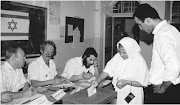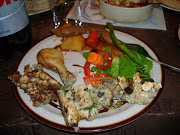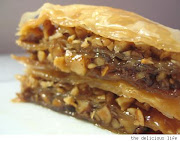1.)Countrys and their cultures.Anonymous.http://www.everyculture.com/
2.) "Israel."The 2010world book Ensyclopedia.2010ed
3.)Rivoin,Lilly.Welcome to Israel.New york city:Aviben, 2004
4.)Heller,Joseph.The Birth of Israel.Florida:Bengurion,2000
Wednesday, May 12
Fun Facts

1.)
Israel has a well-known philharmonic orchestra. The country has produced such classical music stars as violinist Yitzhak Perlman and pianist and conductor Daniel Barenboim.
2.)
Pop music and rock and roll also have a large following, particularly in Tel Aviv, where local stars such as Ofra Haza, Ilanit, and Shalom Hanoch perform to enthusiastic audiences.
3.)
Israel also has a lively tradition of folk dances, which are performed by professional troupes and at occasions such as weddings. The hora , a circle dance, is one of the most commonly performed.
4.)
The Israeli style is highly influenced by European art, but much of it deals explicitly with Jewish themes and issues.
History

Israel has had many historical accomplishments but im going to only tell you three.The first is when israel finally shatterd the sacred myths.Another is in 1896 a monument was discovered in Thebes.Also since its inception, Israel has absorbed more than 3 million immigrants, more than five times the number of Jews living in the country when it attained independence in 1948. Israel is about 290 mile sin length and 85 miles in width.All though, israel is small in size it has a large population.Some people in israel live in urban centers.
Israel`s Food

Falafel , ground chickpeas mixed with onions and spices formed into balls and fried, are served in pita bread as a sandwich. Other popular dishes include tabuleh (a salad of bulgar wheat and chopped vegetables), hummus (chickpea paste), grilled meats, and eggplant. Cumin, mint, garlic, onion, and black pepper are used for flavoring. Baklava is a popular dessert of Arabic origin and consists of flaky dough layered with honey and nuts. Coffee is often prepared in the Turkish style, extremely strong and thick and served in small cups.
The Economy

Israel's economy was originally based on a socialist model, in which the Histadrut
People voting in an election. Israel is a parlimentary democracy, divided into six administrative districts.
trade union was the most powerful organization, controlling most of agriculture, industry, and health care. In the past few decades, Histadrut's power has been diluted as the country has adopted more capitalist policies. The economy today is based largely on advanced technology. Its high-tech firms play an important role in the global economy, and foreign investment in these firms is abundant. Despite its limited natural resources, the country has become nearly self-sufficient in food production (with the exception of grains). Still, agriculture accounts for only 2 percent of the GDP and employs roughly 2 percent of the labor force. Services account for 81 percent and industry for 17 percent. The Israeli economy grew significantly during the 1990s, thanks to an influx of skilled immigrants and growth in the technology sector. While 2000 was the most financially successful year in Israel's history, gains in prosperity, and particularly foreign investments, feel somewhat tenuous after the recent outbreaks of violence. Israels main exports are farm products such as olive oil , wine, and grains, also dry nuts such as almonds , perfume and spices. Israels imports were raw materials such as tin ,lead , silver, copper, iron, gold and timber,and white linen cloth. Israel had econiomic losses during the 1980's.
US Dollar = 7.51152 Israeli New Shekel
The Culture
According to the Bible, Israel is the name given by God to Jacob. The modern country of Israel includes two distinct nationalities, the Palestinian and the Jewish. Each nationality is inextricable from its religious identity. The Palestinians are Arabs whose traditions are founded in Muslim culture; the Jews define their culture in large part around their religion as well. Each group identifies as part of a larger, international religious and cultural community, and each has a history in the region that goes back to ancient times.In Israel 75.4% are Jewish, 20.6 Arab,and 4% minority groups.The Jewish religion was the most popular religion in Israel and always has been.The Jewish people mostly wore black.
http://www.everyculture.com/
http://www.everyculture.com/
Geography!

The exact coordinates of Israel are, 31 30 N, 34 45 E. Israel has four main geographic regions , they are , The Coastal Plain , The Galilean-Samarian-Judian Highlands, The Negev Desert , and The Jordon Rift Vally. The Continent that Israel is located on is Asia. In Israel there are a lot of interesting features some would say incredible. these features are such as , rocky hills, the great sandy desert , roads and highways, there's also the Central Mountains Plateau.
The Millitary

Israel Defense Force (IDF) is ground,naval, and air. The service age is 18. Manpower availability for men is 201,400. Manpower availability for women is 1,535,400.
Army
The Israeli ground forces are highly mechanized. Their equipment inventory included nearly 4,000 tanks and nearly 11,000 other armored vehicles. Their armored personnel vehicles almost equaled in number those of the combined armies of Egypt, Jordan, and Syria. The offensive profile of the army was bolstered significantly by the artillery forces (principally self-propelled and equipped with advanced fire control systems and high-performance munitions). Antitank capabilities had been upgraded with modern rocket launchers and guided missile systems
Navy
By far the smallest arm of the IDF, the navy in 1987 consisted of about 1,000 officers and 8,000 enlisted personnel, including 3,200 conscripts. An additional 1,000 reserve personnel would be available on mobilization. The navy is not designated as a separate service. Officially known as the Sea Corps (Hel Yam), the navy enjoys more autonomy within the IDF structure than the official designation would suggest. The commander has the status of senior advisers to the chief of staff. Along with the ground force area commanders, the commander of the navy holds two-star rank.
Air Force
The air force is not designated as a separate service. Officially known as the Air Corps (Hel Avir), the air force, enjoy more mechainery within the IDF structure than the official designation would suggest. The commander has the status of senior adviser to the chief of staff. Along with the ground force area commanders, the commander of the air force holds two-star rank. In 1988, the air force consisted of about 28,000 men, of approximately 9,000 were career professionals, and 19,000 were conscripts assigned primarily to air defense units. An additional 50,000 reserve members were available for mobilization. As of 1999, the IAF strength of 32,500 included some 22,000 conscripts who mostly served in the air-defence brigades. Reservists numbered 54,000
The military consists of the Israel Defense Forces (ground, naval, and air troops), the Pioneer Fighting Youth, the Frontier Guard, and Chen (composed of women). All citizens, men and women, are required to serve in the armed forces. For unmarried women, two years of active duty are required (not in combat); for men, a minimum of four years. Military expenditures total $8.7 billion annually, 9.4 percent of the GDP.
The Government

Israel's government is parliamentary democracy. There are five divisions. Central, Haifa, Jerusalem, Northern, Southern, and Tel Aviv. Jerusalem is the capital. Israel became free on May 14, 1948. They have no formal constitution. Their legal system is made up of English law and religious system. The voting age is 18.
Benjamin Netanyahu is Israel prime minster.
The Land

Israel is 12,706 square miles. The boarering countries are Egypt, Jordan, Lebanon, and Syria. The terrain there is very different. There are deserts, coastal plains, central mountains, and the Jordan rift valley. The lowest elevation is 1300 feet at the Dead Sea. The hightest elevation is 3955 feet at Har Meron. The natural resources are timber, potash, copper ore, natural gas, phosphate rock, magnesium bromide, clays, sand, and oils. The land use is 17% Arable, 4% permanent crops, 7% permament pastures, 6% woodland, and 66% others. There are 300 settlements in all.
Subscribe to:
Posts (Atom)





